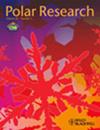环斑海豹(Pusa hispida hispida)在极地周围的体型变化:形态、生态型或仅仅是极端可塑性的证据?
IF 1.3
4区 地球科学
Q3 ECOLOGY
引用次数: 6
摘要
环斑海豹是一种小型的酸性海豹,分布在北部的环极地区。长期以来,人们一直认为环斑海豹的体型是可变的,并认为存在大小不同的生态型。这项研究利用来自35个地点的形态计量数据,探索了北极亚种大部分区域的体型(长度和周长)和成熟年龄模式。渐进长度从113到151厘米不等,位点分为五个不同大小的簇(每个性别)。成熟年龄在3.1至7.4岁之间,性成熟早期的部位通常成熟时长度较小,最终体长较小。两性在某些部位的长度不同,但两性异形的模式并不一致。最大的环斑海豹出现在格陵兰岛西部和加拿大东部,最小的出现在阿拉斯加和白海。纬度趋势只出现在加拿大北极东部地区。周长(考虑长度和季节)也高度可变,但没有显示出显著的空间模式;雄性往往比雌性更圆胖。需要从坎吉亚(格陵兰岛)和加拿大北部的“巨人”开始进行基因研究,以确定它们是否是基因上不同的生态型。还需要进行更多的研究,以了解本研究中证实的导致环斑海豹显著区域大小差异的生态联系,并了解其对潜在适应气候变化的影响。本文章由计算机程序翻译,如有差异,请以英文原文为准。
Variation in body size of ringed seals (Pusa hispida hispida) across the circumpolar Arctic: evidence of morphs, ecotypes or simply extreme plasticity?
The ringed seal is a small phocid seal that has a northern circumpolar distribution. It has long been recognized that body size is variable in ringed seals, and it has been suggested that ecotypes that differ in size exist. This study explores patterns of body size (length and girth) and age-at-maturity across most of the Arctic subspecies’ range using morphometric data from 35 sites. Asymptotic lengths varied from 113 to 151 cm, with sites falling into five distinct size clusters (for each sex). Age-at-maturity ranged from 3.1 to 7.4 years, with sites that had early ages of sexual maturity generally having small length-at-maturity and small final body length. The sexes differed in length at some sites, but not in a consistent pattern of dimorphism. The largest ringed seals occurred in western Greenland and eastern Canada, and the smallest occurred in Alaska and the White Sea. Latitudinal trends occurred only within sites in the eastern Canadian Arctic. Girth (with length and season accounted for) was also highly variable but showed no notable spatial pattern; males tended to be more rotund than females. Genetic studies are needed, starting with the “giants” at Kangia (Greenland) and in northern Canada to determine whether they are genetically distinct ecotypes. Additional research is also needed to understand the ecological linkages that drive the significant regional size differences in ringed seals that were confirmed in this study, and also to understand their implications with respect to potential adaptation to climate change.
求助全文
通过发布文献求助,成功后即可免费获取论文全文。
去求助
来源期刊

Polar Research
地学-地球科学综合
CiteScore
3.20
自引率
5.30%
发文量
22
审稿时长
>12 weeks
期刊介绍:
Since 1982, Polar Research has been the international, peer-reviewed journal of the Norwegian Polar Institute, Norway''s central institution for research, environmental monitoring and mapping of the polar regions. Aiming to promote the exchange of scientific knowledge about the Arctic and Antarctic across disciplinary boundaries, Polar Research serves an international community of researchers and managers. As an open-access journal, Polar Research makes its contents freely available to the general public.
Original primary research papers comprise the mainstay of Polar Research. Review articles, brief research notes, letters to the editor and book reviews are also included. Special issues are published from time to time.
The scope of Polar Research encompasses research in all scientific disciplines relevant to the polar regions. These include, but are not limited to, the subfields of biology, ecology, geology, oceanography, glaciology and atmospheric science. Submissions from the social sciences and those focusing on polar management and policy issues are welcome. Contributions about Antarctica are particularly encouraged.
 求助内容:
求助内容: 应助结果提醒方式:
应助结果提醒方式:


